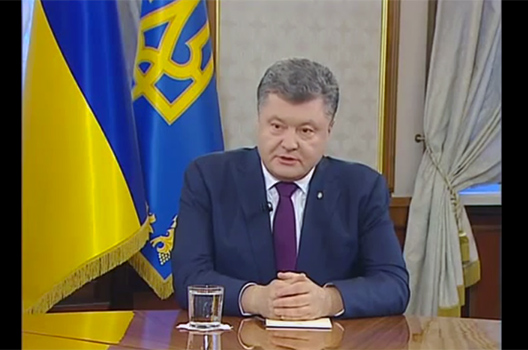
A Cease-Fire, if It Holds, Could Let the Kremlin Strengthen Its Grip on the Donbas Region
When Ukraine’s President Petro Poroshenko attended the NATO Summit on Friday, it was clear that the Alliance had chosen not to offer his country the weapons it needs to fight the Russian troops and paramilitaries who have invaded his country, Atlantic Council experts say. So as Poroshenko accepted instead the symbolic support of a meeting with President Barack Obama and other NATO leaders, he instructed his government to accept a risky Plan B: a cease-fire and negotiations with Russia that could give the Kremlin effective control of much of Ukraine’s industrial center.
The problem is not negotiations, but rather that Ukraine is being forced into them from an unnecessarily weak position because of the transatlantic community’s halting pace in offering support — whether sanctions or military help. Poroshenko’s aides signed the truce days after Russian had sent entire units of its military (from, for example, its 76th and 98th Airborne Divisions) to reinforce its assault on Ukraine. The Russian advance included the opening of a new front along the Azov Sea.
The sporadic shelling of the past three days suggests that the truce may not hold. But if it does, it will give Russian President Vladimir Putin more opportunity to reinforce his military, and the Russian-Ukrainian militias it has sponsored, in Ukraine. Poroshenko’s government, of course, will race as well to rebuild its own armed forces for a next round of battle – and we may see soon which side has done better.
Ukraine’s Risky Strategy
Poroshenko and his government now must try desperately to avoid losing more ground through the negotiations for some kind of government in the Russian-occupied zone. A key Poroshenko political adviser, Yuriy Lutsenko, laid out his government’s strategy in an essay Sunday (Sept. 7) for the Kyiv-based news website Ukrainska Pravda. To preserve its eventual ability to reclaim real sovereignty over the Russian-occupied zone in southeastern Ukraine, Poroshenko intends to avoid any “constitutional arrangement that will allow the criminal gang leading the Donbas to corrupt Ukraine’s path to reform or to veto Ukraine’s European future,” Atlantic Council Senior Fellow Adrian Karatnycky wrote in an e-mail to colleagues.
For Poroshenko, this is a political tightrope made narrower because he must negotiate with Ukraine’s foe amid domestic political campaigning for next month’s parliamentary election. He cannot be seen in Ukraine to surrender any elements of Ukrainian sovereignty, or to weaken Ukraine’s hopes of eventually defeating Russia’s invasion. His narrow domestic space for maneuver is underscored today by criticism of the truce from a political rival, former Prime Minister Yulia Tymoshenko. The cease-fire lacks a provision for the withdrawal of Russian troops, she said in a statement on her website, and thus risks perpetuating their presence in a way to create a “frozen conflict” zone such as those Moscow controls in nearby Moldova and Georgia to maintain influence over those countries.
Putin’s Man in Donetsk
With the truce, Putin’s resources for creating such a “frozen conflict” in Ukraine are powerful. In July, the Kremlin installed its most experienced practitioner of such dirty wars, Lieutenant General Vladimir Antyufeyev, as “deputy prime minister” for security in the Russian-sponsored “Donetsk People’s Republic.” Antyufeyev, a longtime Russian and Soviet police and special operations commander, led KGB operations in Transnistria, the Russian-occupied “frozen conflict” zone in Moldova.
For Antyufeyev and Putin, the strengthening of Russia’s control over much of Donetsk and neighboring Lugansk provinces may be even easier than in Transnistria, notes Atlantic Council Senior Fellow Ian Brzezinski. That’s because they can move troops, weapons and other resources directly across the frontier from Russia. The truce agreement calls for the border to be monitored by the Organization for Security and Cooperation in Europe, or OSCE, but it is unclear what effect if any this might have on Russia’s routine deployment of forces and weapons across the border. “Moscow will use the time … to strengthen its grip on the region – politically, economically and probably militarily,” Brzezinski said. “This strategy that [Poroshenko’s aide] Lutsenko outlines really risks accepting the same fate for Eastern Ukraine as seems to be emerging for Crimea,” which Russia formally annexed last spring.
As Ukrainians contemplated this truce over the weekend, the demand was immediate and widespread for the government to leap quickly to rebuild and re-arm the country’s ill-equipped and hastily recruited and trained military. Several current and former officials called for that strategy yesterday. Kyiv-based political and security analyst Taras Berezovets, a former Ukrainian national security council staffer, called the truce “a difficult but necessary decision.” He predicted that the cease-fire could last for some months, or only some days. Either way, he said, Ukraine must use it to reform its military and prepare for a second round of war against Russia that may require a plan, “on the Swiss defense model,” for nationwide guerrilla warfare.
Meaning that the next round of war in Ukraine, when it comes, will be deadlier and more costly than this one.
James Rupert is an editor at the Atlantic Council.
Image: Ukrainian President Petro Poroshenko accepted a truce with Russia as it became clear NATO would not offer weapons to help it defend itself. (Ukrainian presidential administration)
